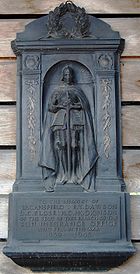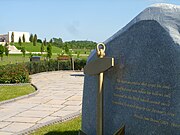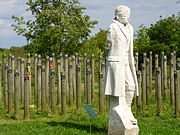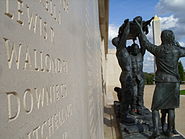| National Memorial Arboretum | |
|---|---|
 View looking towards the Armed Forces Memorial. | |
| Location | Alrewas, Staffordshire, England |
| Coordinates | 52°43′34″N 1°43′41″W / 52.726°N 1.728°WCoordinates: 52°43′34″N 1°43′41″W / 52.726°N 1.728°W |
| Area | 150 acres (0.61 km2; 0.23 sq mi) |
| Created | 16 May 2001 |
| Operated by | The Royal British Legion |
| Website | thenma.org.uk |
The National Memorial Arboretum (grid reference SK185144) is a national site of remembrance at Alrewas, near Lichfield, Staffordshire, England. It gives its purpose as:
The National Memorial Arboretum honours the fallen, recognises sacrifice and fosters pride in our country. It is a spiritually uplifting place and is emerging as a world-renowned centre for remembrance.[1]
Origins[]
The idea for the arboretum was conceived by David Childs in 1988. He believed that it would form a living tribute to service men and women for future generations to reflect upon and enjoy. The arboretum was officially opened on 16 May 2001. It is a registered charity[2] and is part of the Royal British Legion family of charities.
Location[]

Aerial view, with River Tame at bottom.
The Arboretum is situated just south of Alrewas on approximately 150 acres (0.61 km2; 0.23 sq mi) of old gravel workings, 5 miles (8.0 km) north of Lichfield, Staffordshire. It is adjacent to the confluence of the River Tame with the River Trent, and directly neighbouring Croxall Lakes. It is at the western end of the National Forest, just off the A38 road.
Features[]

Sun Insurance company WWII memorial relocated to the arboretum
The arboretum contains over 50,000 trees, with more being added each year.[3]
There are over 250 memorials and plots for the armed forces, civilian organisations and voluntary bodies who have played a part in serving the country; and even HMS Amethyst's cat. Several corporate war memorials – from British banks, building societies, and insurance companies – have been relocated to the grounds,[4] when the original owners became unable or unwilling to care for them. At the heart of the arboretum is the Armed Forces Memorial, which is a tribute to over 16,000 service personnel who have lost their lives in conflict or as a result of terrorism since the end of the Second World War.[5] At 11 am on 11 November each year the sun shines through two slits in the outer and inner walls of the memorial, casting a shaft of light across a wreath in the centre.[6]
Within the arboretum is the Millennium Chapel of Peace and Forgiveness where, at 11 am each day, an act of remembrance takes place. Following the two minutes silence, accompanied by the Last Post and Reveille, there is an introductory talk about the arboretum.[7] The Armed Forces Memorial was dedicated in October 2007 by the Archbishop of Canterbury in the presence of the Queen.
In 2010, the Volunteers of the National Memorial Arboretum were awarded The Queen's Award for Voluntary Service,[8] the highest award that any voluntary group can received, equivalent to the MBE.
Memorials[]
Some of the other features of the National Memorial Arboretum are described below.
| Features | Description |
|---|---|
 |
Association of Jewish Ex-Service Men and Women
Made from Chinese granite and designed to give a different perspective when viewed from different angles, the Star of David memorial is dedicated to Jewish servicemen who were killed on duty. |
 |
Berlin Airlift Monument The memorial is erected in tribute to those who took part in the Berlin Airlift, the operation to deliver food and supplies to Berlin between June 1948 and May 1949. This sculpture features hundreds of intricate steel feathers. It was designed and manufactured by Anwick Forge in Lincolnshire. |
 |
Boys' Brigade
The elements of this garden represent all parts of the UK and Ireland. The Boys’ Brigade Garden is designed to remember those who have served in the Brigade since 1883. 16 Victoria Crosses have been awarded to former and serving Brigade members. |
 |
Burma Railway
The memorial is constructed from 30 metres of the original rails and sleepers used on the Burma Railway, which were brought to the arboretum from Thailand in HMS Northumberland in 2002. The memorial is a permanent tribute to those who were forced to construct the infamous ‘Railway of Death’ and the benches and trees around the railway track have relevant dedications. The memorial was dedicated on 15 August 2002.[9] |
 |
Commandos
The Commandos were formed by the Army in June 1940 as a well-armed but non-regimental raider force employing unconventional and irregular tactics to assault, disrupt and reconnoitre the enemy. This memorial consists of a reproduction of part of the Association badge – the wreath in copper and the Fairbairn-Sykes fighting knife in stainless steel. It was created at Anwick Forge in Lincolnshire. |
 |
Polar Bear Memorial
The Polar Bear Association Memorial was the first monument and sculpture to be erected at the National Memorial Arboretum. It is a tribute to the 49th Infantry West Riding Division and was dedicated on 7 June 1998. In the Second World War they were stationed in Iceland and because they were snowed in under 20 feet (6.1 m) of snow for most of the campaign, their commanding officer called the men ‘his Polar Bears’ and the Polar Bear on a block of ice was soon adopted as their mascot and shoulder flash. Made from yellow hardwood, the bear is 9 ft long (2.7 m) and 5 ft high (1.5 m) and weighs 2.5 tonnes; it was created by the Essex Woodcarvers and took six men a year to carve. Inside the bear is a capsule containing the names of the members of the 49th Division who died, together with relevant letters and documents. |
 |
Royal National Lifeboat Institute (RNLI)
The RNLI memorial has been landscaped as a pebble, shingle and sand beach. The dramatic figure of a lifeboat man in his 19th-century oilskins and cork lifejacket was sculpted by Andrew Fitchett. |
 |
Shot at Dawn
During the First World War some 306 British and Commonwealth soldiers were shot for desertion or cowardice; the real cause for their offences was often a psychological reaction to the stresses of war which today would be diagnosed as post-traumatic stress syndrome or combat stress reaction. Shot at Dawn is modelled on Private Herbert Burden, of the 1st Battalion Northumberland Fusiliers, who was shot at Ypres in 1915 aged 17. |
 |
Stillbirth and Neonatal Death Society (SANDS) Garden
The SANDS Garden is for bereaved parents. At the centre of the garden is a sculpture of the SANDS tear drop logo which was created by John Roberts and the Portland Sculpture Trust to encourage people to sit and touch the central carved figure of the baby. |
 |
The Polish Service Men and Women Memorial
A dedicated memorial has been erected in recognition of the contribution made by Polish service men and women to the Allied Forces during the Second World War. The centre monument sculptured by Robert Sobocinski was unveiled by His Royal Highness the Duke of Kent on 19 September 2009.[10] |
| The Beat
It is a memorial to all British policemen who have died on duty. Its trees are horse chestnut, because old-type British policemen's truncheons were made of horse chestnut wood. | |
| Garden of the Innocents
This memorial is to children who have been affected by war or conflict. The central tree is a elder tree in memory of Anne Frank; each April its flowers and flower buds are removed, to symbolize that Anne Frank was not allowed to grow to adulthood and achieve her full life. | |
| The Irish Mercantile Marine Plinth
This plinth was unveiled on 1 September 2001. The plaque on the plinth has an Irish Tricolour and the words "Dedicated to all those who were serving on the following Neutral Irish Registered Vessels lost as a result of German action 1939-1945", followed by a list of ships lost. The front of the plinth has a plaque dedicated to Irish seamen captured while serving in the British Merchant Navy. They were not accorded POW status, but were treated as slave labourers. This plaque names the five (of 32) who died from ill-treatment. |
References[]
- ↑ NMA Guidebook (2009) introduction
- ↑ THE NATIONAL MEMORIAL ARBORETUM COMPANY LIMITED, Registered Charity no. 1043992 at the Charity Commission
- ↑ National Memorial Arboretum - Trees
- ↑ Gough, P.J., (2004) Corporations and commemoration – First World War Remembrance, Lloyds TSB and the National Memorial Arboretum, International Journal of Heritage Studies, Winter 2004, pp. 435 – 455, ISSN 1352-7258
- ↑ National Memorial Arboretum - Armed Forces Memorial
- ↑ Inscription on memorial
- ↑ National Memorial Arboretum - Chapel
- ↑ "The Queen’s Award for Voluntary Service 2010" (PDF). Cabinet Office. 2 June 2010. http://www.direct.gov.uk/prod_consum_dg/groups/dg_digitalassets/@dg/@en/documents/digitalasset/dg_188086.pdf. Retrieved 30 January 2011.
- ↑ Memorial for 'Railway of Death' veterans
- ↑ Jamieson, Alastair (20 Sep 2009). "Memorial statue for Polish servicemen and women unveiled". http://www.telegraph.co.uk/news/uknews/6210099/Memorial-statue-for-Polish-servicemen-and-women-unveiled.html.
External links[]
| Wikimedia Commons has media related to National Memorial Arboretum. |
The original article can be found at National Memorial Arboretum and the edit history here.



